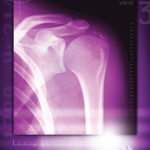In the peripheral areas of the larger calcifications, researchers found that the cells were similar to chondrocytes, because they expressed the transcription factors Runx2 and Sox9, which are associated with cartilage formation. But they found the cells in this area did not express collagen II, a critical protein found in articular cartilage.
Calcification in the cartilage can be associated with the death of chondrocytes, so investigators looked for caspace-3, a protein that’s linked with apoptosis of these cells. But they found that those chondrocyte-like cells around the larger calcifications actually didn’t express this protein.
Dr. Darrieutort-Laffite said the findings likely indicate the various stages of the disease. “Chondrocyte-like cells were observed around larger deposits and could be involved in the mineralization process,” researchers wrote. “Interestingly, they differ from the cells of the fibrocartilage as they did not express collagen II.”
Dr. Darrieutort-Laffite said more investigation needs to be done to understand the mechanisms at work. “Further analyses are necessary to understand the first steps of the process and the regulatory factors involved,” she noted.
Imaging
Another study by French researchers found that ultrasound of the wrist performed better than traditional X-ray in detecting calcium pyrophosphate deposition (CPPD), said Alice Combier, MD, a rheumatology resident at the Bichat Hospital in Paris.3
In the study, 32 patients with CPPD and 26 controls, who had other rheumatic diseases, including rheumatoid arthritis and spondyloarthritis, had a wrist ultrasound performed and X-rays taken of the wrist. Blinded reviewers looked for what researchers called chondrocalcinosis (CC)—imaging features that suggest CPPD.
CC was found on ultrasound in 30 joints and on X-ray in 17 joints in the CPPD patients, amounting to a significant difference (P<0.001). The sensitivity and specificity of ultrasound were 94% and 85%, respectively, compared with 53% and 100% for radiography.
Researchers also found that on ultrasound, sensitivity was higher, at 81%, at the triangular fibrocartilage, than at the radiocarpal joint, at 50%.
“Our study suggests,” Dr. Combier said, “that wrist ultrasound should be considered a relevant tool for the diagnosis of CPPD, with higher sensitivity than radiography.”
Thomas R. Collins is a freelance writer living in South Florida.
References
- Bertrand J, Nitschke Y, Fuerst M, et al. Decreased levels of nucleotide pyrophosphatase phosphodiesterase 1 are associated with cartilage calcification in osteoarthritis and trigger osteoarthritic changes in mice. Ann Rheum Dis. 2012 Jul;71(7):1249–1253. doi: 10.1136/annrheumdis-2011-200892. Epub 2012 Apr 17.
- Darrieutort-Laffite C, Najm A, Garraud T, et al. Histological characterization of rotator cuff calcific tendinopathy (abstract OP0190). Annual European Congress of Rheumatology. 2017 Jun 15. Madrid, Spain.
- Combier A, Forien M, Gardette A, et al. Comparison of ultrasonography and radiography of the wrist for diagnosis of calcium pyrophosphate deposition (abstract OP0191). Annual European Congress of Rheumatology. 2017 Jun 15. Madrid, Spain.
